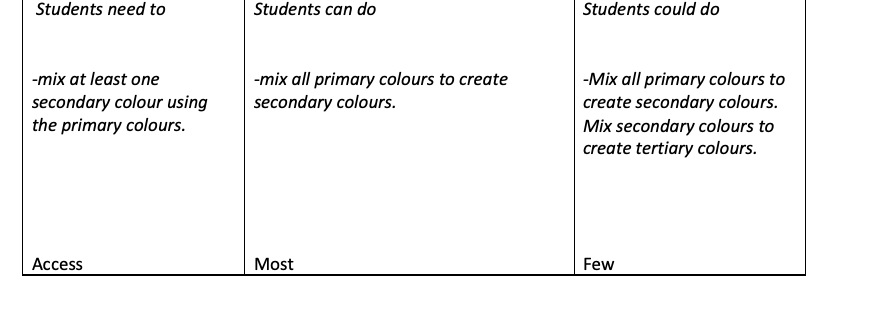Inclusive education has always been important to me and became even more important to me through discussion with my coaching teacher who is a huge advocate for inclusive education. She really encouraged me to develop access points for each lesson that would be accessible to all students no matter their development level. Not only do I always ensure that I include an access point and an extension for students when planning lessons, but I also make sure to provide supports for students during lessons. This is most evident in math where I always provide different manipulatives for students. For example I used dice a lot for students to practice their learning. I would provide different dice with different sides for all students to choose from. Most students would choose the dice that worked for their ability while others had the opportunity to try a more challenging dice.
Below is an example of how I approach inclusive education while lesson planning
When planning all lessons I start with this chart above. What I expect from most students is what goes into the middle box. I then think about what every single student in my class is able to do and that becomes my access point. I then move on to the extension piece which is the final box on the right. In this box I put examples of how students could extend during this lesson. It is important to ensure that the access point is something every student will be able to do. It is also important that all students are aware of the criteria to meet the access point, but also have the criteria for the middle, as well as the criteria for extension.
For example the chart above is from an art lesson on primary colours where students experimented with primary colours to make secondary colours. When I explained this to students I told them that I wanted to them to try and mix all primary colours into secondary colours. I then told them that if they wanted to go a step farther they could mix secondary colours to create tertiary colours. This ensured that all students were working to mix colours and would mix at least one secondary colour therefore reaching the access point. All students in the end did meet the middle criteria of mixing all three primary colours to create the secondary colours, which is great. Only a few students could mix secondary colours to create tertiary colours and explain to me the process which is also great.
I will continue to use this model when planning lessons. As I have gone through three practicums using this method for planning lessons it has become much easier for me to decide access points and extensions for lessons relatively quickly. This way of developing differentiated criteria is also helpful for assessment as the criteria is easily turned into a learning standard where students can then be assessed on.

